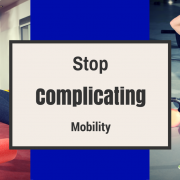Stop Complicating Mobility Work
Read Time: [5 minutes]
It’s been interesting to see how Crossfit has affected the consumption of goods and services across the entire landscape of fitness.
I was talking to a good friend of mine who has been a personal trainer for over 20 years. He was there well before Crossfit became a fitness phenomenon and he’s been able to see how the landscape changed because of it. He was telling me that rowing machines used to just collect dust and chalk used to cost pennies on the pound.
One of the more interesting trends is the rise in demand for better ways to take care of yourself. People are actively looking up videos about mobility, stretching, and exercise to help make their bodies feel and function better.
If you were to talk to people in the world of therapy, corrective exercise, or sports medicine, they would tell you that getting anyone to do home care was like pulling teeth. People wanted quick fixes and for the doctor or therapist to do all of the work for them. Even getting professional athletes; people who get paid to keep their bodies in shape; to do home care was a chore.
The rise of guys like Kelly Starrett (MobilityWoD), Ryan DeBell (The Movement Fix), Zach Long (The Barbell Physio), Tim Simansky (The WoD Doc), and Scott Mills (The Full Body Fix) have seemingly done the impossible. They’ve made self-care a lot sexier.
But Then It Got So Complex
Chiropractors and physiotherapists all over the world saw how well these pioneers executed their programs and started blogging and making videos showing their tips and tricks for mobility.
But does anyone get the feeling that a lot of the tips and tricks are turning into a competition to see who can make their drills look more complex or complicated than the last guy?
It also feels like there’s a bunch of tools and objects being sold that are redundant, but look crazy enough to be worth buying. For example:
Anyone need to up their stability exercise game?
For most people, the best mobility is time spent in the desired position
I was working with a guy that just started Crossfit. He came from a traditional body building background so he was in phenomenal shape, but he really liked the Crossfit style workouts and wanted to be great at it. However, he was having a lot of issues with his squat.
If you know anything about Crossfit, you know that the squat and all of it’s variations are fundamental to success. It had never really been part of his regiment, so his mobility was lacking and was complicated by his sheer bulk and strength.
His heels would come off the ground, lower back would round, and knees dived inward in a squat with no weight.
His coaches gave him a variety of advice like:
- Mash your ankles with the lacrosse ball
- Mash your quads with a foam roller
- Tie a band to the rig and floss your hips
- Do this yoga pose
He did all of these things for several weeks, but he just wasn’t getting anywhere from an improvement stand point. This isn’t anything against the knowledge of his coaches, because they weren’t wrong, they were absolutely right to make the recommendations they made.
The problem was that those recommendations wasn’t the primary issue. His biggest issue was that his body spent very little time in a full squat position. Sometimes the mobility answer is just that simple. Spend time in the desired position.
So what’d we do?
His goal was to get to the bottom of his squat. So we got him to spend time in the bottom of the squat for minutes at a time.
I had him perform this drill against a wall every day for a total of 5 minutes.

Static Wall Squat Drill
Within 2 weeks, he could squat with his heels on the ground. In another 2 weeks he could keep his chest up 50% more.
Once he could squat with good technique, then we had him perform the drill off the wall in neutral, and on the wall with his hands over head so he could prepare for the overhead squat.
It isn’t mindblowing or sexy, but sometimes the answers just have to be….
Simple.
Sometimes mobility means training the muscles and your nervous system to just spend time in the desired position.
We just have to make sure that we keep the person’s goal in mind for a mobility recommendation.
Start Easy, Master Skill, Increase Load, Increase Difficulty
This isn’t to say that different tools and complex movement patterns aren’t important. They are! The better your body is able to handle and tolerate simple tasks, then complexity of movement is what allows for further growth and improvement.
But sometimes we have to take a step back and look at where we currently are, and ask ourselves if we are ready for a more complex movement.
As an example, I like to use the average person doing an overhead squat. If your overhead squat causes you to bend your elbows, lean off your heels, and collapse your lumbar curve then you have some glaring mobility issues in the overhead position.
If you cannot do a basic overhead squat, do you think it is going to benefit you to do more complicated drills like a snatch or a Sots press? Probably not. You need to get your Overhead Squat position right first.
Here is the basic formula:
- Perform the easiest variation of a movement.
- Mobilize and practice movement in desired range of motion
- Master complete movement with full range of motion
- Increase weight
- Increase difficulty and complexity
So if you want to do the same with the squat:
- Being with partial squat using a ball or bench.
- Use mobility techniques and practice being in the desired range of motion
- Master a full depth squat without assistance
- Slowly increase to using a barbell and increasing weight
- Progress to pause squats, overhead squats, pistol squats, etc
Going from steps 1 through 5 can take weeks and weeks of practice. In some cases, it may take several weeks just to perform a basic movement to mastery. But you will get their a lot better, safer, and faster when you tackle this with a plan as opposed to throwing together random mobility strategies from a Youtube video in a haphazard way.











